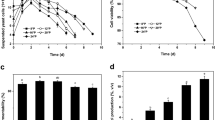Abstract
The rate of ethanol production increased with increasing wort gravity up to the initial wort concentration of 24%, reaching the maximum ethanol concentration of 6.2%, but its attenuation reached only 49%. The intracellular trehalose accumulation was proportional to the inital wort gravity, at 24 or 30% wort fermentation increased 3 or 4.5 times, respectively, compared to 12% wort fermentation. Trehalose accumulation began after exhaustion of glucose, ceased after uptake of approximately 65% reducing saccharides, despite of increasing ethanol or remaining saccharide concentration in the environment.
Similar content being viewed by others
References
Bilinski C.A., Russell I., Stewart P.R.: Applicability of yeast extracellular proteinases in brewing: physiological and biochemical aspects.Appl. Environ. Microbiol. 53, 495–499 (1987).
Casey G., Magnus C.A., Ingledew W.M.: High gravity brewing: nutrient enhanced production of high concentrations of ethanol by brewing yeast.Biotechnol. Lett. 5, 429–434 (1983).
Bafrncová P., Foltin T., Sláviková I., Šmogrovičová D.: Selection of yeast strain for alcohol fermentation using high glucose concentrations.Folia Microbiol. 44, 100 (1999).
Lilie S.H., Pringle J.R.: Reserve carbohydrate metabolism inSaccharomyces cerevisiae: response to nutrient limitation.J. Bacteriol. 143, 1384–1394 (1980).
Majara M., O'Connor-Cox E.S.C., Axcell B.C.: Trehalose—an osmoprotectant and stress indicator compound in high and very high gravity brewing.J. Am. Soc. Brew. Chem. 54, 149–154 (1996).
Pátková J., Šmogrovičová D.: Stress factors acting during very high gravity wort fermentation.Folia Microbiol. 45, 82 (2000).
Slaughter J.C., Nomura T.: Intracellular glycogen and trehalose contents as predictors of yeast viability.Enzyme Microb. Technol. 14, 64–67 (1992).
Stewart G.G., D'Amore T., Panchal C.J., Russell I.: Factors that influence the ethanol tolerance of brewers yeast strains during high gravity wort fermentations.Tech. Quart. MBAA 25, 47–53 (1988).
Stewart P.R.: Analytical methods for yeast, in D.M. Prescott (Ed.):Methods in Cell Biology. Vol. 12, Academic Press, New York 1975.
Thomas K.C., Hynes S.H., Ingledew W.M.: Practical and theoretical considerations in the production of high concentrations of alcohol by fermentation.Proc. Biochem. 4, 321–333 (1996).
Author information
Authors and Affiliations
Rights and permissions
About this article
Cite this article
Pátková, J., Šmogrovičová, D., Bafrncová, P. et al. Changes in the yeast metabolism at very high-gravity wort fermentation. Folia Microbiol 45, 335–338 (2000). https://doi.org/10.1007/BF02817557
Received:
Issue Date:
DOI: https://doi.org/10.1007/BF02817557




